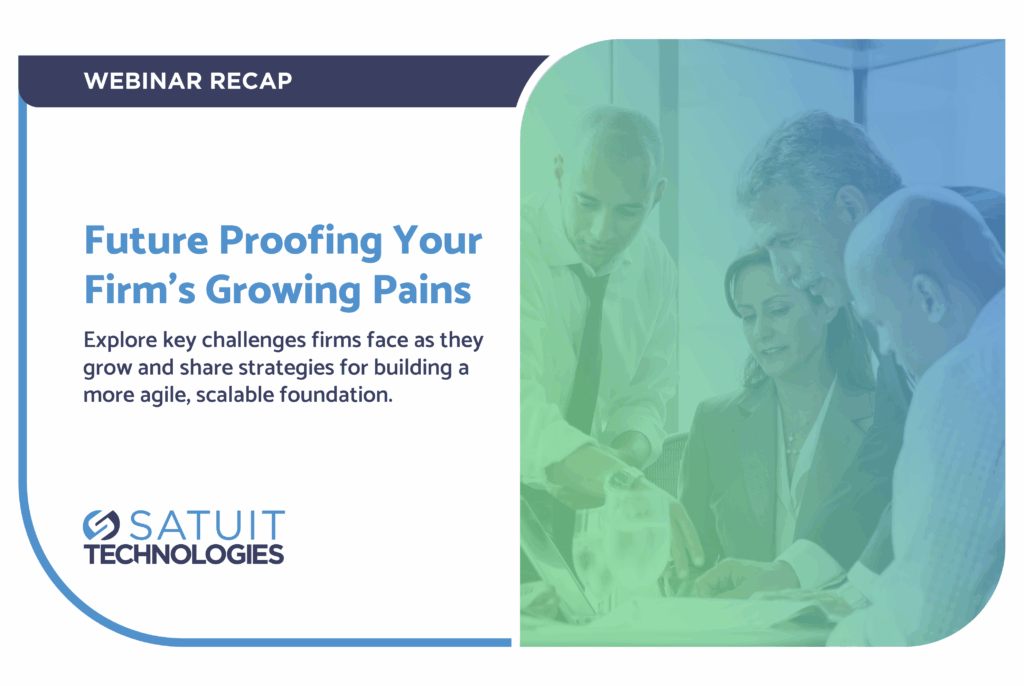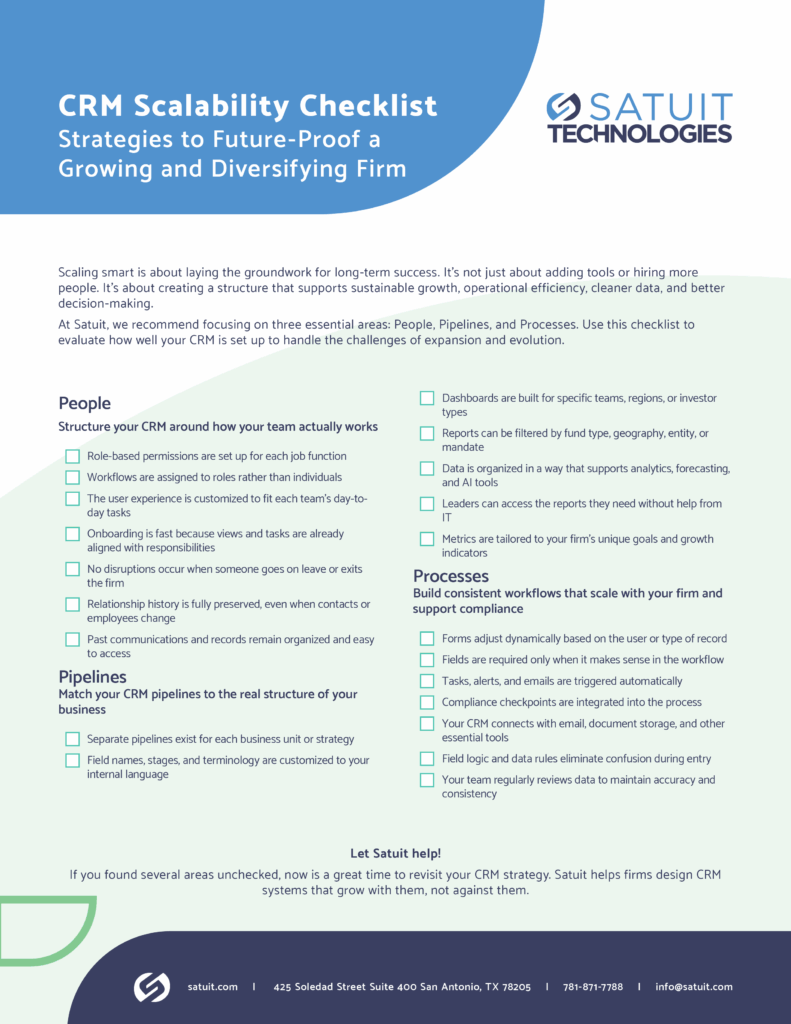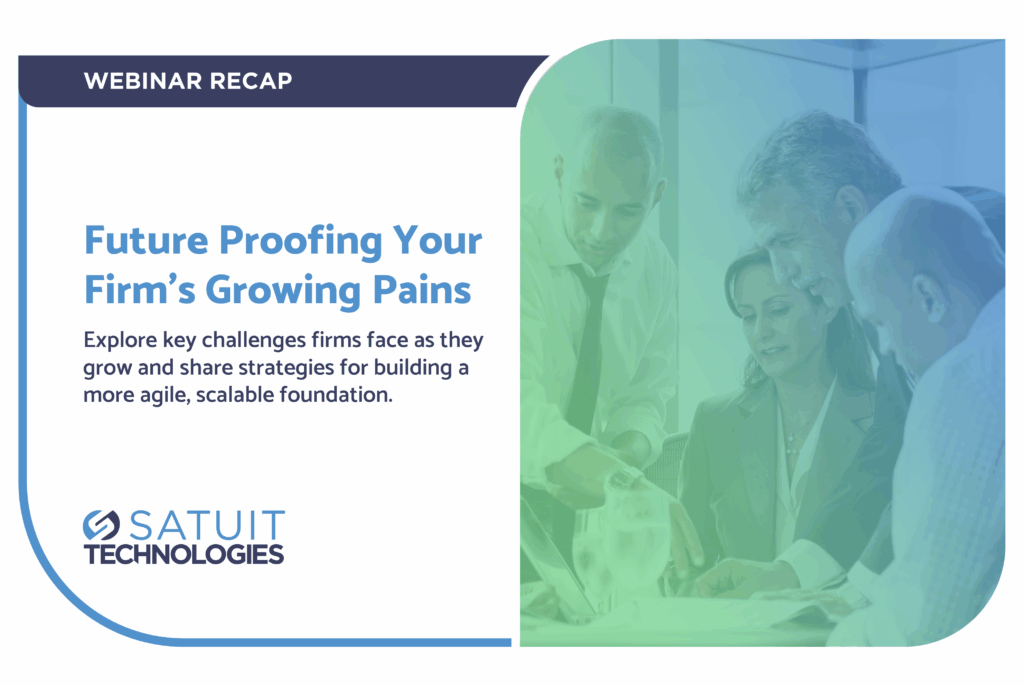Joshua Weiss, Senior Vice President and CTO at Satuit Technologies discusses how integrations within a CRM can enhance data management, increase efficiency and transparency, and deliver ROI for asset management firms.
Most firms are starting to recognize that CRM integration can improve both efficiency and productivity. While this may be apparent, many firms often find it difficult to make those integrations happen, lacking the skills and resources to do so. While some 95% of companies strive to enable their business ecosystems, 38% lack confidence in their capacity to support their integration initiatives.[1] With the right tools in place, managing integrations to create a CRM ecosystem can be simple, even for users who are not as tech-savvy.
Why Clients Integrate

Benefits of CRM integration for Asset and Wealth Management Firms?
Proper Integration can improve CRM data management, efficiency, and transparency, and lower costs of other systems, increasing your CRM’s ROI.
CRM Data Management
Effective data management depends on the accuracy, completeness, and timeliness of data to ensure it is available to anyone who needs it and is authorized to access it. CRM integration supports data management by eliminating duplicative data entry and record-keeping, making processes more scalable. A properly integrated CRM will remove repetitive, incorrect data, such as having one client that is recorded under three names such as ‘James’, ‘Jamie’ and ‘Jim’. Having accurately attributed data is vital when dealing with client assets, as is the case for firms that utilize wealth management CRMs.
When you have a ‘golden source’ of information in one system that flows downstream to all other systems, integration can minimize CRM data integrity issues. For example, employees working with asset management software require accurate, updated data, as they are oftentimes dealing with substantial figures. Inconsistent accessibility to data for institutional asset managers and their employees can cost your company productivity, results, and even clients.
Reduced Costs for Other Systems
Many CRM users may need access to data from other systems like a Portfolio Accounting System (PAS). By integrating key data from these systems, such as market values, transactions, etc., firms can reduce the costs of licensing these systems for sales and service employees while making the data easily available to them in the CRM.
Benefits for Asset and Wealth Management Reporting
CRM integration also allows for the breaking down of data silos, which increases firm-wide transparency and makes it possible to gain a 360-view of client relationships, resulting in improved reporting. By allowing information to flow across different systems, less time is spent on data management, and fewer licenses are needed for third-party software, which delivers immediate ROI and cost savings.
Identifying the Right Integration Method for Your Firm
CRM integration requirements differ from business to business. With multiple approaches available, it is important to select the method that aligns with the firm’s expertise. At Satuit we recognize this and provide solutions tailored to certain industries, including private equity, hedge funds, institutional asset management, family offices, and more.
Pre-built solutions integrate with many popular third-party solutions to perform the most common types of integration required by your team – often requiring no additional work. These take the form of in-app plug-ins, integration links, data import tools, such as our secure data exchange solution, and pre-built integrations with productivity and e-marketing tools.

A McKinsey Global Institute analysis revealed that integration technology can help improve overall productivity by 20-25%.
Integration for Improved CRM Organization and Data Analysis
Integration links allow data from within a CRM to be passed to another website as part of a URL, which is then opened in a new browser window. Users can leverage these customizable URLs to pass contact’s address information to Google Maps, for example, or open client-specific folders on SharePoint, and link third-party data services using unique IDs, for more efficient CRM data analysis.
Like integration links, embedded links provide a way to pass information that started in the CRM to a URL, but rather than opening a new window, they display the website within the application. Embedded links are used in tasks such as embedding widgets, displaying information from web-based data stores, and accessing SharePoint sites.
Import tools give any moderately tech-savvy user the ability to import data from a CSV file into any primary data table using reusable field mappings and are ideally suited for monthly investment data updates, adding contact lists from a new employee or a conference, consolidating data from multiple systems, and data maintenance. This can streamline the creation of reports, especially when paired with additional tools, such as client report automation software.
More advanced CRM integration may require APIs designed for developers and business analysts that can access all primary data tables within an application for real-time systems integration. For jobs that involve updating high volumes of data, developers can opt for a bulk API that can run on a daily schedule. In addition, advanced tools like Satuit’s Data Utility allow users like business analysts to configure and maintain integrations using bulk APIs without writing code.
With moderate technical skills, it is possible to leverage CSV files and user-friendly importing mappings that provide added performance and pre-built exception handling benefits. More tech-savvy users will be able to use import tools to schedule data imports, or export data from user-created saved views or Microsoft Report Builder Reports, for example. Even limited data transformation can be accomplished with these easy-to-use tools.
CRM integrations that require more complex ‘extract, transform, load’ (ETL) functionality can be built and managed with Microsoft SQL Server Information Services (SSIS). This provides two-way file exchanges with other data stores, transferring files via SecureFTP sites. Clients typically opt for this approach for data-intensive updates that may involve some level of data transformation between the source database and the CRM.
Regardless of whether clients are using import tools such as APIs or SSIS, they can still benefit from two-way integrations with other data sources. CRM system integration enables coordination between back and middle office software to gain a 360-degree view of their investor and prospect relationships.
Ultimately, CRM integration provides a flexible, cost-effective way for clients to get the most out of the best-in-class tools they already have in place, using their available resources and expertise – enhancing data management, efficiency, transparency, and ROI.
Asset and Wealth Management CRM Software Solutions
At Satuit we know the labor involved in acquiring new clients and servicing existing accounts for asset and wealth management firms. Our SatuitCRM, Secure Investor Portal, Client Report Automation, Secure Data Exchange, and Mobile CRM App software solutions provide your organization with the tools to manage, track and securely transfer sensitive data.
Contact us today to learn more about how our software solutions can benefit your business.
To learn more about Satuit’s integration tools for end-users, business analysts, and application developers in the asset management community, contact us today.






